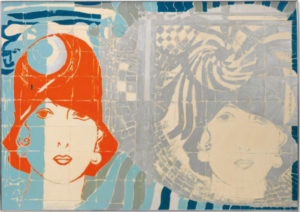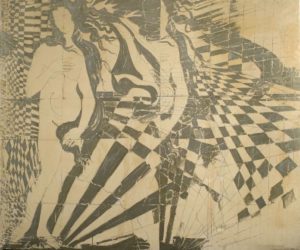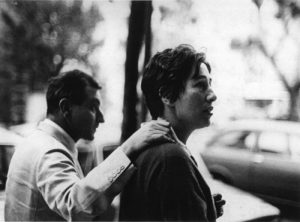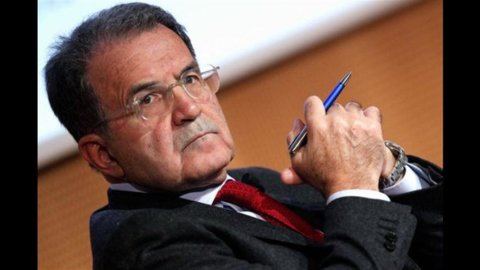After nearly twenty years of substantial predominance of informal abstractionism, with his work he has brought attention to new possibilities of figurative language.
He was born in Rome into a family of artists. His father Mario is a sculptor. The mother Francesca puppeteer. The pharmacist grandfather loved to surround himself with poets, among the which Vincent Cardarelli. Giosetta attends the Academy of Fine Arts where the meeting with All Scialoja, who directed her, is decisive for her training as an artist. "ANDrto an incredible man, pallidissimo and dressed all in black, he looked like a mime”, as he describes it in a beautiful interview with Flash Art. “Fhe received lessons on Russian theater, American comedians, BusterKeaton, Charlie Chaplin. We were in 1956-57, Scialoja he was already frequenting New York, it was him – continues the artist – to tell us aboutAction Painting, of great American painting by Arshilegorky, by Mark Rothko. just Rothko then he came to Italy and I hosted him in my little house by the sea, we spent a wonderful day with his wife and daughter". GiosettaFioroni has no doubts: iin a certain sense Scialoja it was a point of origin of all the movements of the sixties in Rome. "Is born everything from him. Mario Schifano, Tano Festa, Franco Angels… We all met there. All he spoke to us about theater, about Chekhov done by Stanislavsky, and of course of Malevich… In short, he talked about things that nobody knew anything about, we were all like thirsty……è was a great teacher, he was extraordinary: he jumped on the table and danced to mime the dance of Sergej Diaghilev. The whole world has been revealed to us da him… The world of art things".

Vienna Liberty (1966)
Painting , Mixed technique , 100cm x 141cm
Private collection
From 1959 to 1963 he lived in Paris, where the gallery Denise leg dedicates a personal exhibition to her. She returned to Rome, she and she was the only female figure to be part of the legendary movement of the School of Piazza del Popolo, together with Franco Angeli, Mario Schifano, Tano Festa, Francesco Lo Savio, Fabio Mauri. With some of them you participate in the Venice Biennale in 1964 and exhibit at the Tartaruga gallery of Plinio De Martiis in Rome, a point of reference for many Italian and international artists, including Cy twombly, and where in 1968 Giosettainaugurates the Teatro delle Mostre with the performance La Spia Ottica. His first experiences with the camera and photography and his "toys for adults", the Teatrini, date from this same period. He begins to collaborate with poets and writers, such as Alberto Arbasino, Nanni Balestrini, Andrea Zanzotto, Cesare Garboli, Guido Ceronetti, Frank Marcoaldi and many others, designing books and graphic works with them.
He spends the seventies at Salgareda, in Veneto, with his partner, the writer Goffredo Parise. He reads Russian Vladimir's fairy tale studies Propp (morphology of the fairy tale) and composes the cycles of the sylvan spirits, black ink drawings and display cases, wooden boxes that hold small collections of objects found in the woods and countryside. In 1975 he presented the Atlas of forensic medicine in Rome. He exhibited, between the seventies and eighties, at the Galleria Naviglio in Milan, Lucio Amelio in Naples, De ' Foscherari in Bologna, Dell'Oca in Rome, Mazzoli in Modena, Corraini in Mantua, Studio Bernabo in Venice and in 1970 the Tartaruga gallery in Rome presented a solo show entitled Laguna: the silver landscapes are born. Also in 1970 he took part in the Vitality of the Negative exhibition, curated by Achille Bonito Oliva at the Palazzo delle Esposizioni in Rome.

Birth of a Venus Op. (Botticelli), 1965.
Private collection. Photo © Michele Alberto Sereni
Tell the work of Giosetta Fioroni also allows us to speak of Italian art from the sixties under a different profile, less pro-American and more authentically Italian. It allows us to free the image we have of Roman artists from the heavy burden of American Pop Art, which was certainly important, but which is marginal if we focus on the peculiarities of the Italian phenomenon.
Paris and Rome. The name of these two cities where the artist lived (he still lives and works in Rome) and cultivated his visionary research is enough to give an idea of the distance that separates Giosetta Fioroni from the Pop imaginary with which it is usually associated. Explains the art historian Giulio Vaccher. Paris, capital of European culture in the years in which the baton is passing to New York, is a lively city, a laboratory of the present and at the same time a place of tradition. In the French capital Fioroni binds to the informal painters Joan Mitchell and Jean Paul Riopelle and comes into contact with the art critic Pierre Stay che introduces her to the work of Yves Klein, deepening the contact of the artist with the artistic avant-garde of his time, divided between the informal experiences and the new experiments of the New Realism. Between Paris and Rome, in the years from 1957 to 1962, Giosettaflowers – continues Vaccher – traces the fundamental foundations of one's artistic career. emerges theattention to recollection and layers of memory, evoked through extensive fields of color, scribbles and small signs. A sort of “narrative tone” subterraneanly guides sketches and scribbles, stains, shapes and small emblems. Signs that become words, words that become figures. An abstract painting that ultimately does not renounce the message and the narration. On the other hand it is the stit Fioroni - in a statement of 1964 - to distance himself from his fellow travelers: "There doesn't seem to be anything in common between the experiences of Pop Art and what I do, also because that is a fact linked to a type of American society. Personally, a certain type of literature has influenced me more, a certain type of sequence and appearances”. More than Pop, the art of Giosetta Fioroni – underlines Giulio Vaccher – it seems to us to be the figurative expression of a unique and unrepeatable time of Italian culture. The time in which a society recovering from Fascism, from war and from a tiring reconstruction, raises its head and finally knows well-being. A time when artists feel they have to adjust their way of feeling to a rapidly changing society. An art that speaks of a new way of seeing and a new relationship with the image, which, on closer inspection, means a new relationship with history and with one's own memory. A varied and complex phenomenon that would be simplistic to include within the definition of Italian Pop Art.
Giosetta Fioroni (Rome 1932 )
Study atRome Academy of Fine Arts, student of AllScialoja. He exhibits at the VII Quadrennial of Rome from 1955. In 1956 he worked as a costume designer for the nascent Italian television. From 1959 to 1963 he lived in Paris. Back in Rome, she is the only figfemale ure to be part of the so-called "School of Piazza del Popolo", together with Franco Angeli, Mario Schifano, Tano Festa, Francesco Lo Savio, Fabio Mauri, Giuseppe Uncini. With some of them he participates in the Venice Biennale in 1964. His story is humanly marked by the sought-after closeness with the writers and men of letters, belonging to Group 63, and above all with Goffredo Parise (writer translated into Russian since the end of the Sixties) who he became her partner from 1963 until his death in 1986. Since 1970 he has participated in important exhibitions. In 2009 an important historical-biographical monograph of the artist was published, edited by Germano Celant. In 2013 the Drawing Center in New York dedicates the anthology to her “Giosetta Fioroni. Silver”, curated by Claire Gilman. In 2015 the MADRE of Naples presents, in one of the rooms of the museum, the exhibition "theaters-cribs”, ceramic works created by the artist at the Gatti workshop in Faenza, accompanied by the publication of a catalog with texts by Giorgio agamben, Marzio Breda, Erri De Luca, Raffaele La Capria and Ermanno Rea. The same year, one of his solo shows curated by Piero Mascitti and Marco mean goes on stage at the MARCA in Catanzaro. Meanwhile the Centre Pompidou in Paris acquires one of his works, a canvas from the Silver cycle of the XNUMXs entitled The glasses. In October 2017 the MMOMA – Moscow Museum of Modern Compaction in Moscow is hosting one of his personal exhibitions entitled "Roma anni '60". It is then the turn of Milan which in April 2018, at the Museo del Novecento, dedicates a monographic exhibition entitled "Sentimental Journey" to her, curated by Flavio Arensi and Electra Bottazzi.

© Parise Archive - Fioroni
Transfer market
After a long period of calm flat, for some years (two – three) quotations of the works di Giosetta Fioroni hasnno started a gradual and steady ascent . A path virtuous which closely follows that of his former street companions of the School of Piazza del Popolo (Angeli, Festa, Schifano among thei others) and which is powered by theactivism of some galleriesie dealing with his work and the artist's recent exhibition activity is – thanks also to the commitment of some important art critics – in the last two years he has scoredor personal exhibitions in Italian and international public and private institutions of relief. Over 500, to date, its passages in auction in the various types with a percentage of sold (especially in the last two years) around 70% e a turnover than in 2017 - second Artprice - exceeded 370 thousand euros.
Reference galleries: Marcorossi contemporary art in Milan; Mucciaccia From Rome; de Foscherari of Bologna and Corraini of Mantua.
Prezzi: In the gallery land cards made by the artist negli Sixties can be purchased for figures ranging from 15 to 30 thousand euros depending on the size, while the works on canvas - always from that period – require an investment of between 80 and 100 thousand euros (for large formats). The worksrecent editions on medium format paper cost from 10 to 15 thousand euros. Those on canvas 30-40 thousand euros.
Top price at auction"Family Interior”, a painting on canvas from 1960 (11,54×146,5 cm.) sold for 86.557 euros (rights included) in April 2017, setting a new record for the artist. A few months earlier, in October 2016, a work by him at Phillips in London, "The Glasses (The Glasses), 1968 – a mixed technique on canvas measuring 130 x 85 cm changed hands for 71 euros.





